- Home
- About Journals
-
Information for Authors/ReviewersEditorial Policies
Publication Fee
Publication Cycle - Process Flowchart
Online Manuscript Submission and Tracking System
Publishing Ethics and Rectitude
Authorship
Author Benefits
Reviewer Guidelines
Guest Editor Guidelines
Peer Review Workflow
Quick Track Option
Copyediting Services
Bentham Open Membership
Bentham Open Advisory Board
Archiving Policies
Fabricating and Stating False Information
Post Publication Discussions and Corrections
Editorial Management
Advertise With Us
Funding Agencies
Rate List
Kudos
General FAQs
Special Fee Waivers and Discounts
- Contact
- Help
- About Us
- Search

The Open Electrical & Electronic Engineering Journal
(Discontinued)
ISSN: 1874-1290 ― Volume 13, 2019
Battery Losses In a MMC for BEVS Application
Adolfo Dannier*, Gianluca Brando, Ivan Spina, Diego Iannuzzi
Abstract
Objective:
This paper analyses the Modular Multilevel Converter (MMC) topology, where each individual Sub Module (SM), in half bridge configuration, is directly fed by an elementary electrochemical cell.
Methods:
The aim is to investigate how the reference voltages influence the cells currents waveforms, determining how the active powers and the losses are distributed among the cells. Considering a 2-level Voltage Source Inverter (VSI) topology working in the same conditions, the ratio between the MMC total cells losses and VSI total cells losses is calculated. After showing the system architecture and mathematical model, the cells current waveform investigation is presented and detailed both for triangular and sinusoidal voltage reference waveform.
Results:
Finally, the results are critically discussed with particular focus on the comparison between the MMC and the VSI topologies.
Article Information
Identifiers and Pagination:
Year: 2018Volume: 12
First Page: 98
Last Page: 109
Publisher Id: TOEEJ-12-98
DOI: 10.2174/1874129001812010098
Article History:
Received Date: 26/6/2018Revision Received Date: 15/9/2018
Acceptance Date: 27/9/2018
Electronic publication date: 30/10/2018
Collection year: 2018
open-access license: This is an open access article distributed under the terms of the Creative Commons Attribution 4.0 International Public License (CC-BY 4.0), a copy of which is available at: https://creativecommons.org/licenses/by/4.0/legalcode. This license permits unrestricted use, distribution, and reproduction in any medium, provided the original author and source are credited.
* Address correspondence to this author at the Department of Electrical Engineering and Information Technologies – University of Naples Federico II, Claudio 21, 80125 Naples, Italy; Tel: +390817683233; E-mail: adolfo.dannier@unina.it
| Open Peer Review Details | |||
|---|---|---|---|
| Manuscript submitted on 26-6-2018 |
Original Manuscript | Battery Losses In a MMC for BEVS Application | |
1. INTRODUCTION
Over the last decades, several legislative regulations have been introduced with the aim to encourage and stimulate a flawless transition from traditional Internal Combustion (IC) based vehicles to Battery Electric Vehicles (BEVs) [1 Explaining road transport emissions, European Environment Agency - ISBN: 978-92-9213-723-6 - ORDER ID (Catalogue Number): TH-04-16-016-EN-N]. Indeed, full electric based traction drives have overall efficiency of 80% while offering zero emission of Greenhouse Gases (GHG) and other air pollutants, which, instead, are the main drawbacks of conventional vehicles. However, the public uptake of electric vehicles is strongly hampered by the reduced energy density and limited lifetime of the batteries, the low diffusion of the charging stations in both urban and extra-urban area and, last but not least, the long recharge times. In particular, the lifetime of the batteries are strictly dependent on the use of the batteries and the system architecture. Generally, since the battery is directly connected to the main DC-bus, the number of series-connections is imposed by the desired DC-link voltage, while the number of parallel-connections is subjected to the required total energy of the storage system [2J. Yun, T. Yeo, and J. Park, "High efficiency active cell balancing circuit with soft switching technique for series-connected battery string", Power Electron. Conf. Expo., pp. 3301-3004.Long Beach, CA, USA]. Even though the battery cells are ideally charged or discharged by the same current, the correspondent terminal voltage and State-of-Charge (SOC) will be different because of the electrochemical characteristics differences, which would lead to an unbalanced power contribution [3J. Kim, Shin C. Chun, and B.H. Cho, "Stable configuration of a Li-ion series battery pack based on a screening process for improved voltage/SOC balancing", IEEE Trans. Power Electron., vol. 27, no. 1, pp. 411-424.
[http://dx.doi.org/10.1109/TPEL.2011.2158553] ] and to premature failure of the battery over extended cycling due to individual cells overcharging/undercharging. Therefore, passive or active Battery Management Systems (BMSs) are added to the battery [4M. Daowd, M. Antoine, N. Omar, P. Van Den Bossche, and J. Van Mierlo, "Single switched capacitor battery balancing system enhancements", Energies, vol. 6, no. 4, pp. 2149-2174.
[http://dx.doi.org/10.3390/en6042149] ] in order to dramatically increase the cells lifetime. The BMS has the main purpose of dynamically minimizing the cells imbalance during normal operations in order to preserve the battery lifetime [5H. Rahimi-Eichi, U. Ojha, F. Baronti, and M.Y. Chow, "Battery Management System: An Overview of Its Application in the Smart Grid and Electric Vehicles", IEEE Ind. Electron. Mag., vol. 7, no. 2, pp. 4-16.
[http://dx.doi.org/10.1109/MIE.2013.2250351] ]. In this approach, the traction power unit is equipped with an DC/AC converter that connects the DC-link to the AC-motor and/or the AC-grid [6A. Emadi, K. Rajashekara, S.S. Williamson, and S.M. Lukic, "Topological overview of hybrid electric and fuel cell vehicular power system architectures and configurations", IEEE Trans. Vehicular Technol., vol. 54, no. 3, pp. 763-770.
[http://dx.doi.org/10.1109/TVT.2005.847445] ]. Several topologies have been proposed for the main DC/AC converter with the aim to obtain good performance and high conversion efficiency. Among them, multilevel converters are considered as one of the most effective solutions [7G. Brando, A. Dannier, A. Del Pizzo, R. Rizzo, and I. Spina, "Torque derivative control in induction motor drives supplied by multilevel inverters", IET Power Electron., vol. 9, no. 11, pp. 2249-2261.
[http://dx.doi.org/10.1049/iet-pel.2014.0958] , 8G. Brando, A. Dannier, A. Del Pizzo, R. Rizzo, and I. Spina, "Generalised look-up table concept for direct torque control in induction drives with multilevel inverters", IET Electr. Power Appl., vol. 9, no. 8, pp. 556-567.
[http://dx.doi.org/10.1049/iet-epa.2014.0488] ]. In particular, an alternative system architecture can be built upon the Modular Multilevel Converter (MMC) by connecting each individual Sub Module (SM), in half or full bridge configuration, to an elementary battery cell [9L.M. Tolbert, Z.P. Fang, and T.G. Habetler, "Multilevel converters for large electric drives", IEEE Trans. Ind. Appl., vol. 35, no. 1, pp. 36-44.
[http://dx.doi.org/10.1109/28.740843] , 10L.M. Tolbert, J.N. Chiasson, K.J. McKenzie, and Z. Du, "Control of cascaded multilevel converters with unequal voltage sources for HEVs", Electric Machines and Drives Conference, vol. 2, pp. 663-669.]. Generally this converter topology is used for high voltage application, where the most significant features are: high redundancy index, reduced devices ratings, strong scalability, common DC-link for multi-drive applications, low output voltages, excellent fault-tolerance capability, and enhanced motor efficiency/performance in comparison with the traditional two-level Voltage Source Inverter (VSI) [11G. Brando, A. Dannier, Spina I, and Tricoli P, "Integrated BMS-MMC balancing technique highlighted by a novel space-vector based approach for BEVs application", Energies, vol. 10, no. 10, p. 1628.
[http://dx.doi.org/10.3390/en10101628] -13M. Quraan, T. Yeo, and P. Tricoli, "Design and control of modular multilevel converters for battery electric vehicles", IEEE Trans. Power Electron., vol. 31, no. 1, pp. 507-515.
[http://dx.doi.org/10.1109/TPEL.2015.2408435] ].
In the context of Electrical Vehicles (EVs) applications, the MMC can be viewed as a Configurable Modular Multilevel Converter (CMMC) [14M. Tsirinomeny, and A. Rufer, "Configurable Modular Multilevel Converter (CMMC) for flexible EV", In: 2015 17th European Conference on Power Electronics and Applications (EPE'15 ECCE-Europe), Geneva, 2015.
[http://dx.doi.org/10.1109/EPE.2015.7309229] , 15M. Quraan, P. Tricoli, S. D’Arco, and L. Piegari, "Efficiency Assessment of Modular Multilevel Converters for Battery Electric Vehicles", IEEE Trans. Power Electron., vol. 32, no. 3, pp. 2041-2051.
[http://dx.doi.org/10.1109/TPEL.2016.2557579] ]. Indeed, the MMC, in both traction and charger modes, once coupled with a proper balancing control strategy, integrates also the BMS functionality, thus leading to an increased power density [16S. D’Arco, L. Piegari, and P. Tricoli, “A modular converter with embedded battery cell balancing for electric vehicles,” 2012 Electrical Systems for Aircraft., Railway and Ship Propulsion: Bologna, pp. 1-6.]. However, the resulting conversion efficiency could suffer given the high number of required switching devices. An extensive analysis of the semiconductor related losses has shown that the MMC-based architecture has efficiency levels comparable with VSI-based ones [17F. Ciccarelli, A. Del Pizzo, and D. Iannuzzi, "An ultra-fast charging architecture based on modular multilevel converters integrated with energy storage buffers", 2013 Eighth International Conference and Exhibition on Ecological Vehicles and Renewable Energies (EVER), pp. 1-6.Monte Carlo].
Moreover, since each cell delivers a current waveform which is marginally dependent on the converter output mean power, the resulting substantial difference between the RMS and DC value of the cells currents increases the losses of the storage system. This aspect is investigated in this paper, which carries out an in-depth analysis by examining the dependence between the reference cells voltages, the output converter currents and the correspondent cells losses. This approach could be useful for the development of a modulation strategy that aims to minimize the battery losses regardless of the system operating condition.
2. SYSTEM ARCHITECTURE AND MODEL
The MMC system architecture is shown in Fig. (1 )
)
 |
Fig. (1) Modular Multilevel Converter architecture. |
The six arms of the depicted double-star cascaded three-phase converter are built upon N series connected half bridge Sub Modules (SM), each one connected to an elementary cell on the DC side. The whole structure can be seen as two cascaded converters (higher and lower) parallel-connected with respect to the load, series-connected with respect to the total DC-link. In the proposed scheme, the converter phases are connected by six identical inductors, while the total DC-link voltage vdk is derived between points PH and PL. The coupling inductors are needed in order to optimize the parallel connection by properly conditioning the dynamic of the circulating currents coherently with the control time response.
The currents iH,k, iL,k flowing in the k-th arm of the higher, lower converter can be decomposed in their circulating, load components is,k, ic,k:
 |
(1) |
While the load currents is,k are generally linked to the load control law and, therefore, cannot be arbitrarily chosen, the circulating currents ic,k are not subject to such constraints and, consequently, introduce degrees of freedom to the converter control strategy.
The total output voltages vH,k, vL,k of the k-th arm of the higher, lower converter can be expressed as:
 |
(2) |
where SH,k,r, SL,k,r ϵ {0,1} are the switching function of the r-th module belonging to the k-phase of the higher, lower converter. The quantities vdc,H,k,r, vdc,H,k,r are the corresponding elementary cell voltage and depends on its Status Of Charge (SOC) and its delivered current SH,k,riH,k, SL,k,riL,k.
The arm voltages vH,k, vL,k can be decomposed in their total, differential components vσ,k, vδ,k:
 |
(3) |
A better perspective with respect to the definition of the converter control strategy can be brought forth by replacing the generic phase-variables xk with their space vector and common mode components
 . By applying the Kirchhoff voltage laws to the double-star converter, its mathematical model can be synthetically formulated with respect to the space vector and common mode components of is,k, ic,k, vδ,k, vσ,k:
. By applying the Kirchhoff voltage laws to the double-star converter, its mathematical model can be synthetically formulated with respect to the space vector and common mode components of is,k, ic,k, vδ,k, vσ,k:
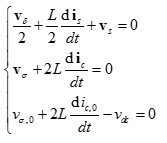 |
(4) |
where vs is the space vector of the load phase voltages vs,k. From (4), it is clear that, while vδ is calculated by the load control law, vσ can be used as an effective control variable by properly driving the space vector of the re-circulating current based on the MMC control strategy. Indeed, ic can be exploited in order to equalize the SOCs of the elementary cells during the converter operation [12X. Liu, A. Lindemann, and H. Amiri, "Theoretical and experimental comparison of different control strategies for modular multilevel converters", In: Proc. IEEE 15th Workshop Control Model. Power Electron., Jun. 22-25, 2014, pp. 1-9.]. Therefore, by effectively controlling ic and by properly distributing the output power of each leg among the correspondent modules, the MMC is able to feed the load while keeping the cells balanced. However, an injection of a circulating current in each converter arm increases the RMS value of the currents, decreasing the total system efficiency. For this reason, in order to compare the MMC architecture to the traditional VSI one with respect to the system efficiency, ic and vσ are set to zero, i.e. no equalization action is performed by the control strategy. Moreover, with reference to the steady state conditions, for which dic,0 / dt = 0 for each value of the converter output modulation index, vσ,0 becomes constrained to the value
 . Under this hypothesis, the reference arm voltages depends only on vδ and vδ,0, which, as per (4), can be freely chosen. In particular, once the higher and lower converters are symmetrically modulated by imposing vδ,0 = 0, the following relations apply:
. Under this hypothesis, the reference arm voltages depends only on vδ and vδ,0, which, as per (4), can be freely chosen. In particular, once the higher and lower converters are symmetrically modulated by imposing vδ,0 = 0, the following relations apply:
 |
(5) |
From (5) it can be noted that the reference voltages of the higher and lower converters are reduced to two three-phase symmetrical systems. In this case, the analysis of the converter steady-state operation can be carried out with reference to one converter arm and extended to the whole structure.
3. WAVEFORM OF THE CELLS CURRENTS
Thanks to the high number of SMs, the load current is typically characterized by low distortion even when the cells are simply connected/disconnected based on the reference voltage value and no PWM technique is implemented. Thus, in normal steady state operation, the current waveform flowing in a specific SM cell depends on 3 factors: the actual SOC of the cell, the reference voltage waveform and the arm current waveform.
The actual SOC of the cell determines its order in the sorting algorithm and thus establishes a voltage threshold across which the cell is inserted and/or disconnected in the circuit. Consequently, the voltage reference waveform fixes the time instants when the SM related to the specific cell is switched ON and OFF. Finally, during the time intervals when the SM is kept ON, its cell experiences the arm current, while during OFF intervals the cell current is zero. In other words, the cell current is the same of the arm one except it is zero during the time intervals where the reference voltage is below the threshold; the threshold depends on the actual SOC of the cell. In Fig. (2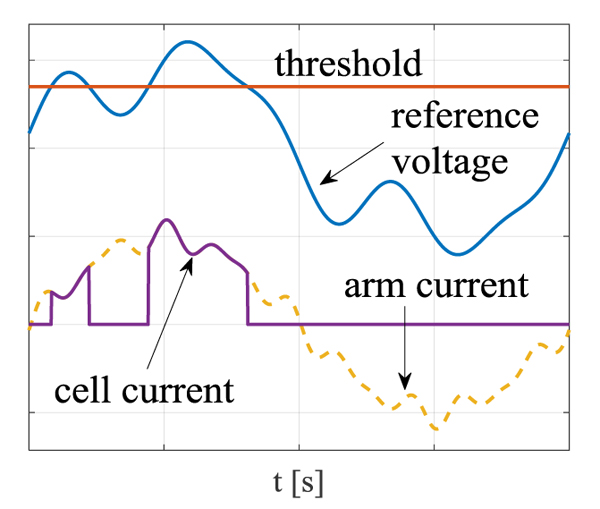 ) a generic voltage reference waveform is compared with a threshold (red line) determining the cell current waveform from a generic load current waveform.
) a generic voltage reference waveform is compared with a threshold (red line) determining the cell current waveform from a generic load current waveform.
 |
Fig. (2) Qualitative behavior of single cell reference voltage and current waveforms. |
Naturally, for N cells per arm there will be N different cell current waveforms, each one instantaneously equal to the arm current in different time intervals. By consequence, each cell will supply a different active power and the sum of all cells different active powers will be equal to the load power; whereas, in traditional VSI every cell delivers the same active power. Thus, for MMC topology it is important to analyze the distribution of the active power among the cells and, and in particular, to evaluate how the unbalanced power distribution influences the total cell losses.
With reference to a single arm of the converter, assuming that the converter cells are kept quite well balanced with regard to their SOCs, they can be simply numbered according to their physical position from bottom to top (Fig. 3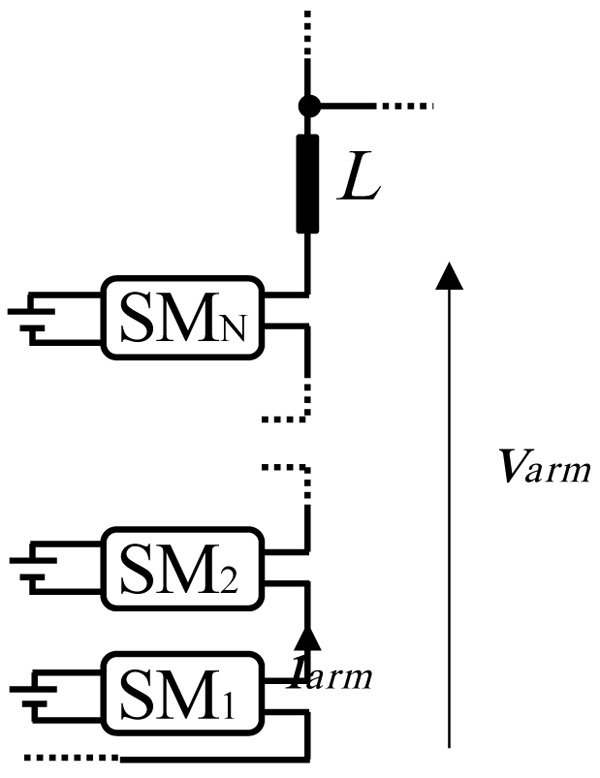 ). In this case each cell is characterized by the same voltage Vcell, so that the voltage threshold value which determines the connection and disconnection of the generic kth cell will be k ∙ Vcell.
). In this case each cell is characterized by the same voltage Vcell, so that the voltage threshold value which determines the connection and disconnection of the generic kth cell will be k ∙ Vcell.
 |
Fig. (3) Detailed representation of a generic MMC arm. |
3.1. Simplified Case
For sake of simplicity, it is supposed that the MMC converter has 100 cells per arm, each characterized by a voltage value of 1 V, so that a reference voltage across 75 V would drive the ON/OFF switching of the 75th SM cell. Under this hypothesis, a voltage absolute value in [V] directly translates to a percentage one in [%].
The load current is assumed sinusoidal and synchronous with respect to the fundamental frequency of the reference voltage. Its peak value is also fixed to 200 % (200 A in the assumed case example), and placed on the peak of the voltage, i.e. the current is aligned with the reference voltage; the arm current peak value corresponds to 100 A (100%).
Since the magnitude and waveform of the generic arm current have been constrained, the distribution of the current among the arm cells only depends on the voltage reference waveform.
3.1.1. Triangular Reference Voltage
If the reference voltage is triangular shaped and with unitary modulation index, the current waveforms of the cells can be derived quite intuitively. Indeed the time instants ton, toff where the generic kth cell is connected/disconnected are linearly dependent on k. For a generic kth cell the situation is that of Fig. (4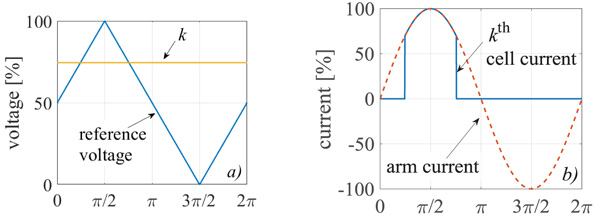 ).
).
 |
Fig. (4) kth cell current waveform for triangular reference voltage. |
The generic kth cell current waveform depicted in Fig. (4b ) can be characterized both in terms of mean value (DC value) and in terms of root mean square value (RMS value); these depending on the time instants ton, toff. When k ≥ 50, ton can be easily calculated by the following:
) can be characterized both in terms of mean value (DC value) and in terms of root mean square value (RMS value); these depending on the time instants ton, toff. When k ≥ 50, ton can be easily calculated by the following:
 |
(6) |
while the time instant toff corresponds to:
 |
(7) |
The active power supplied by the kth cell is proportional to its DC current value; k=50 corresponding to the maximum power. It is worth notice that each couple of cell of the type (100-∆)th and (1+∆)th (with ∆=1,2,...,N/2-1) have complementary current waveform Fig. (5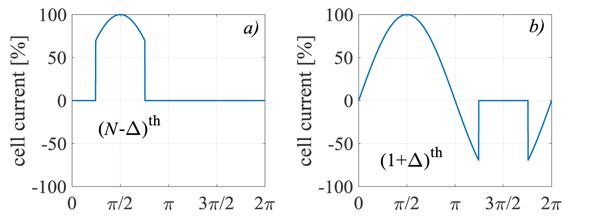 ).
).
 |
Fig. (5) Behavior of complementary cells couple current waveforms. |
The DC current value of the (100-∆)th cell is equal to one of the (1+∆)th cell; the two cells deliver the same active power. Considering all the cells, the DC current values associated with first 50 cells (1st-50th) correspond to the ones of the second 50 cells (51st-100th).
The DC current values distribution among the 51st -100th cells can be calculated from (6) and (7):
 |
(8) |
The remaining 1st-50th cells will be characterized by the same DC current values, so that the total distribution appears as in Fig. (6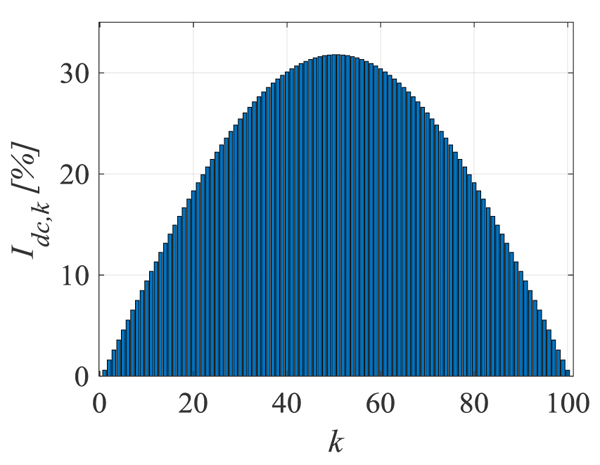 ).
).
 |
Fig. (6) Behavior of DC current values distribution with triangular reference voltage. |
As expected, the distribution of Idc,k is sinusoidal, as a sinusoidal load current waveform has been intercepted by a linear transformation (triangular reference voltage):
 |
(9) |
The total active power supplied by the 100 cells is of course proportional to the sum of Idc,k and so proportional to the average value of Idc,k. The average value of Idc,k can be calculated as:
 |
(10) |
where Idc is the average value of the all 100 cells DC current values.
Although Idc,k is different for each cell, with regard to the active power it is as each cell supply a constant current equal to Idc.
With reference to Fig. (5 ), it is clear that, despite the cell group (100-∆)th and (1+∆)th supply the same active power, their losses are different, being different the RMS current values. In particular the RMS current values of the 1st-50th cells are higher than the ones of the 51st-100th cells. In the discussed case of triangular reference voltage, the distribution of the 100 cell RMS current values Irms,k is the one of Fig. (7
), it is clear that, despite the cell group (100-∆)th and (1+∆)th supply the same active power, their losses are different, being different the RMS current values. In particular the RMS current values of the 1st-50th cells are higher than the ones of the 51st-100th cells. In the discussed case of triangular reference voltage, the distribution of the 100 cell RMS current values Irms,k is the one of Fig. (7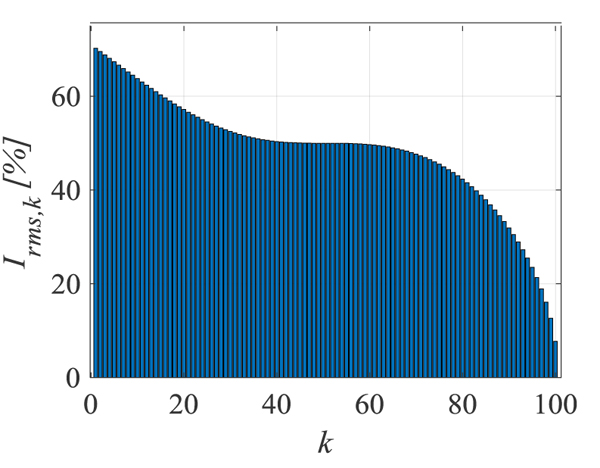 ).
).
 |
Fig. (7) Behavior of RMS current values distribution with triangular reference voltage. |
The average value of all Irms,k can be calculated considering that each of first 50 cell (see (1+∆)th cell of Fig. 5b ) experiences a current waveform equal to the arm one, except for a null interval placed between π and 2π. For each (1+∆)th cell there is a complementary (100-∆)th cell whose current waveform exactly corresponds to the missing part of (1+∆)th cell. Thus, with regard to the average value of all Irms,k, it is as half the cells experiences the total arm current and half the cells has a zero current:
) experiences a current waveform equal to the arm one, except for a null interval placed between π and 2π. For each (1+∆)th cell there is a complementary (100-∆)th cell whose current waveform exactly corresponds to the missing part of (1+∆)th cell. Thus, with regard to the average value of all Irms,k, it is as half the cells experiences the total arm current and half the cells has a zero current:
 |
(11) |
where Irms is the average value of Irms,k among all 100 cells Iarm,rms and is the arm current RMS value.
In a traditional VSI the series connected elementary cells will substantially supply a constant current proportional to the load power. Therefore, their losses will be associated with I 2dc. In the discussed MMC case, instead, the cells losses are associated with I 2rms. It is worth noting that the MMC cells losses are increased by a factor ξ:
 |
(12) |
3.1.2. Sinusoidal Reference Voltage
In normal steady state operation the 3 higher arm reference voltages are a 3-phase symmetrical sinusoidal system and each lower arm reference voltage is opposite to the correspondent higher phase one Fig. (8a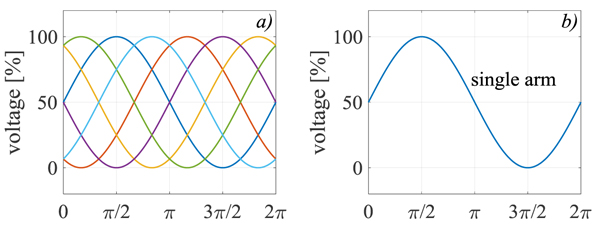 ). Thus, at unitary modulation index, each arm is driven in order to produce the reference voltage of Fig. (8b
). Thus, at unitary modulation index, each arm is driven in order to produce the reference voltage of Fig. (8b ).
).
 |
Fig. (8) Reference voltages for the higher arms (a) and for a single arm (b). |
When k > 50, the time instant ton corresponding to the connection of the cell can be easily evaluated by:
 |
(13) |
while the time instant toff is still given by (7).
The DC current values distribution among the 51th-100th cells can be calculated as:
 |
(14) |
The remaining 1st-50th cells will be characterized by the same DC current values of the 51th-100th ones, so that the total distribution appears as in Fig. (9 ).
).
 |
Fig. (9) Behavior of DC current values distribution with sinusoidal reference voltage. |
The distribution of Fig. (9 ) is a semi ellipse centered at [0;50], and with vertical and horizontal axes respectively equal to 100/π and 50. Thus the average value of all 100 cells DC currents value can be calculated as:
) is a semi ellipse centered at [0;50], and with vertical and horizontal axes respectively equal to 100/π and 50. Thus the average value of all 100 cells DC currents value can be calculated as:
 |
(15) |
With sinusoidal reference voltage, the distribution of the RMS current values among the 100 cells appears as in Fig. (10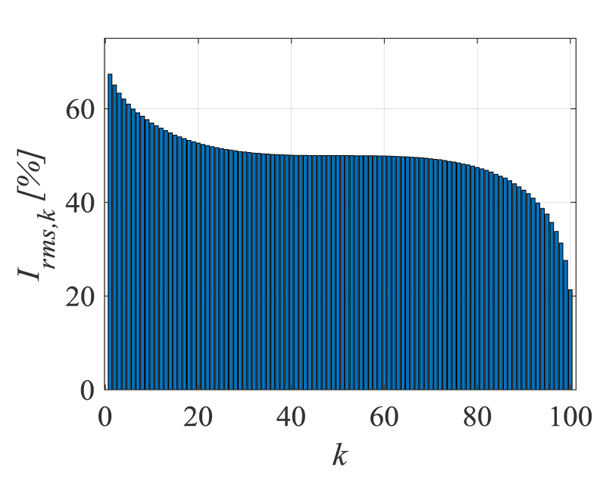 ).
).
 |
Fig. (10) Behavior of RMS current values distribution with sinusoidal reference voltage. |
Although the distribution of Fig. (10 ) is different from the one of Fig. (7
) is different from the one of Fig. (7 ), the quantity Irms doesn’t change (see (11)). Consequently, the ratio ξ between I 2rms and I 2dc is:
), the quantity Irms doesn’t change (see (11)). Consequently, the ratio ξ between I 2rms and I 2dc is:
 |
(16) |
3.2. General Case
A general case of N cells per arm is considered. Each cell is characterized by the voltage Vcell. The load current is sinusoidal with 2Ipk peak amplitude and cosφ power factor. The reference voltages are characterized by a modulation index set to m, and a common mode component set to N ∙ Vcell / 2.
As long as the reference voltage does not contain even harmonics, the time instants ton and toff corresponding to the connection and disconnection of the cell, are symmetrically placed around π / 2 or 3π / 2. This still allows to find couple of cells of the type (N-∆)th and (1+∆)th having complementary current waveform and equal DC current values Fig. (11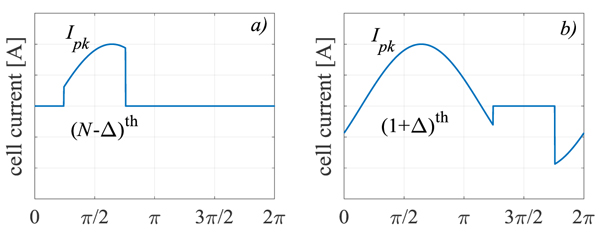 ).
).
 |
Fig. (11) Behavior of complementary cells couple current waveforms. |
The DC current value of the generic kth cell corresponds to:
 |
(17) |
With reference to Fig. (11 ), it is evident that the quantity Irms still satisfies (11) and corresponds to:
), it is evident that the quantity Irms still satisfies (11) and corresponds to:
 |
(18) |
It is worth noting that, differently than in a traditional VSI, Irms only depends on the load current peak value and not on the modulation index or the load power factor. If for instance m is set to zero, since the mean value of the reference voltage is N ∙ Vcell / 2, half the cells will have a current equal to zero and half the cells will experience the total arm current; Irms is still given by the (18). This suggests a strong dependence of Irms from the common mode component of the reference voltages.
3.2.1. Triangular Reference Voltage
With the position z = N / 2, for a triangular shaped reference voltage, the time instant ton corresponding to the connection of the kth cell with z < k ≤ z (1 + m), can be easily calculated as:
 |
(19) |
Considering that each couple of cells of the type (N-∆)th and (1+∆)th have complementary current waveform, and that the kth cells with z (1 - m) < k ≤ z (1 + m) are the only ones with a non-zero DC current value, from (17) and (19) it is easy to verify that:
 |
(20) |
The quantity Idc can then be calculated as:
 |
(21) |
As in a traditional VSI, Idc depends both on the modulation index and on the load power factor. Thus, the factor ξ becomes:
 |
(22) |
The factor ξ represents the increase of the MMC cells losses in comparison with a traditional VSI. As it can be noted, it is inversely proportional to m2 and cos2φ, assuming higher value at lower load power; at the maximum load power (m = 1 and cosφ = 1) its value is around 6.
3.2.2. Sinusoidal Reference Voltage
For a sinusoidal shaped reference voltage, ton can be calculated as:
 |
(23) |
so that the DC current value of the generic kth cell is:
 |
(24) |
Again, the cells DC current values distribution is elliptical with vertical and horizontal axes respectively equal to Ipk ∙ cosφ / π and mz. Thus, the quantity Idc is:
 |
(25) |
and, consequently, the ratio ξ becomes:
 |
(26) |
The considerations regarding the triangular reference voltage case can be also applied to this case, with the difference that ξ = 4 (instead of about 6) at the maximum load power.
CONCLUSION
With reference to a Modular Multilevel Converter (MMC), this paper analyzed the current waveform of the current supplied by the electrochemical cells, both for triangular and sinusoidal reference voltage. Each cell current has been characterized by a different DC value and a different RMS value, and their distribution have been calculated. Moreover, a total DC current value has been derived expressing the total active power supplied by all cells and, analogously, a total RMS current value has been derived linked to the total cells losses.
Differently than in a traditional Voltage Source Inverter (VSI), in the case of MMC, the total RMS current value has been found not dependent on the modulation index or the power factor, determining augmented cell losses for the MMC in comparison with the VSI ones. In particular, for a given value of the load current peak value, the MMC cells losses depend only on the common mode component of the reference voltages, which is constrained if the converter DC-link is not isolated. Instead, in the case of an isolated DC-link, the reference voltage common mode component becomes a degree of freedom which could be exploited in order to minimize the cells losses.
CONSENT FOR PUBLICATION
Not applicable.
CONFLICT OF INTEREST
The authors declare no conflict of interest, financial or otherwise.
ACKNOWLEDGEMENTS
Propulsori elettrici ad eliche controrotanti per imbarcazioni e velivoli leggeri" financed by the Department of Electrical Engineering and IT of the University of Naples Federico II.
REFERENCES
| [1] | Explaining road transport emissions, European Environment Agency - ISBN: 978-92-9213-723-6 - ORDER ID (Catalogue Number): TH-04-16-016-EN-N |
| [2] | J. Yun, T. Yeo, and J. Park, "High efficiency active cell balancing circuit with soft switching technique for series-connected battery string", Power Electron. Conf. Expo., pp. 3301-3004.Long Beach, CA, USA |
| [3] | J. Kim, Shin C. Chun, and B.H. Cho, "Stable configuration of a Li-ion series battery pack based on a screening process for improved voltage/SOC balancing", IEEE Trans. Power Electron., vol. 27, no. 1, pp. 411-424. [http://dx.doi.org/10.1109/TPEL.2011.2158553] |
| [4] | M. Daowd, M. Antoine, N. Omar, P. Van Den Bossche, and J. Van Mierlo, "Single switched capacitor battery balancing system enhancements", Energies, vol. 6, no. 4, pp. 2149-2174. [http://dx.doi.org/10.3390/en6042149] |
| [5] | H. Rahimi-Eichi, U. Ojha, F. Baronti, and M.Y. Chow, "Battery Management System: An Overview of Its Application in the Smart Grid and Electric Vehicles", IEEE Ind. Electron. Mag., vol. 7, no. 2, pp. 4-16. [http://dx.doi.org/10.1109/MIE.2013.2250351] |
| [6] | A. Emadi, K. Rajashekara, S.S. Williamson, and S.M. Lukic, "Topological overview of hybrid electric and fuel cell vehicular power system architectures and configurations", IEEE Trans. Vehicular Technol., vol. 54, no. 3, pp. 763-770. [http://dx.doi.org/10.1109/TVT.2005.847445] |
| [7] | G. Brando, A. Dannier, A. Del Pizzo, R. Rizzo, and I. Spina, "Torque derivative control in induction motor drives supplied by multilevel inverters", IET Power Electron., vol. 9, no. 11, pp. 2249-2261. [http://dx.doi.org/10.1049/iet-pel.2014.0958] |
| [8] | G. Brando, A. Dannier, A. Del Pizzo, R. Rizzo, and I. Spina, "Generalised look-up table concept for direct torque control in induction drives with multilevel inverters", IET Electr. Power Appl., vol. 9, no. 8, pp. 556-567. [http://dx.doi.org/10.1049/iet-epa.2014.0488] |
| [9] | L.M. Tolbert, Z.P. Fang, and T.G. Habetler, "Multilevel converters for large electric drives", IEEE Trans. Ind. Appl., vol. 35, no. 1, pp. 36-44. [http://dx.doi.org/10.1109/28.740843] |
| [10] | L.M. Tolbert, J.N. Chiasson, K.J. McKenzie, and Z. Du, "Control of cascaded multilevel converters with unequal voltage sources for HEVs", Electric Machines and Drives Conference, vol. 2, pp. 663-669. |
| [11] | G. Brando, A. Dannier, Spina I, and Tricoli P, "Integrated BMS-MMC balancing technique highlighted by a novel space-vector based approach for BEVs application", Energies, vol. 10, no. 10, p. 1628. [http://dx.doi.org/10.3390/en10101628] |
| [12] | X. Liu, A. Lindemann, and H. Amiri, "Theoretical and experimental comparison of different control strategies for modular multilevel converters", In: Proc. IEEE 15th Workshop Control Model. Power Electron., Jun. 22-25, 2014, pp. 1-9. |
| [13] | M. Quraan, T. Yeo, and P. Tricoli, "Design and control of modular multilevel converters for battery electric vehicles", IEEE Trans. Power Electron., vol. 31, no. 1, pp. 507-515. [http://dx.doi.org/10.1109/TPEL.2015.2408435] |
| [14] | M. Tsirinomeny, and A. Rufer, "Configurable Modular Multilevel Converter (CMMC) for flexible EV", In: 2015 17th European Conference on Power Electronics and Applications (EPE'15 ECCE-Europe), Geneva, 2015. [http://dx.doi.org/10.1109/EPE.2015.7309229] |
| [15] | M. Quraan, P. Tricoli, S. D’Arco, and L. Piegari, "Efficiency Assessment of Modular Multilevel Converters for Battery Electric Vehicles", IEEE Trans. Power Electron., vol. 32, no. 3, pp. 2041-2051. [http://dx.doi.org/10.1109/TPEL.2016.2557579] |
| [16] | S. D’Arco, L. Piegari, and P. Tricoli, “A modular converter with embedded battery cell balancing for electric vehicles,” 2012 Electrical Systems for Aircraft., Railway and Ship Propulsion: Bologna, pp. 1-6. |
| [17] | F. Ciccarelli, A. Del Pizzo, and D. Iannuzzi, "An ultra-fast charging architecture based on modular multilevel converters integrated with energy storage buffers", 2013 Eighth International Conference and Exhibition on Ecological Vehicles and Renewable Energies (EVER), pp. 1-6.Monte Carlo |



